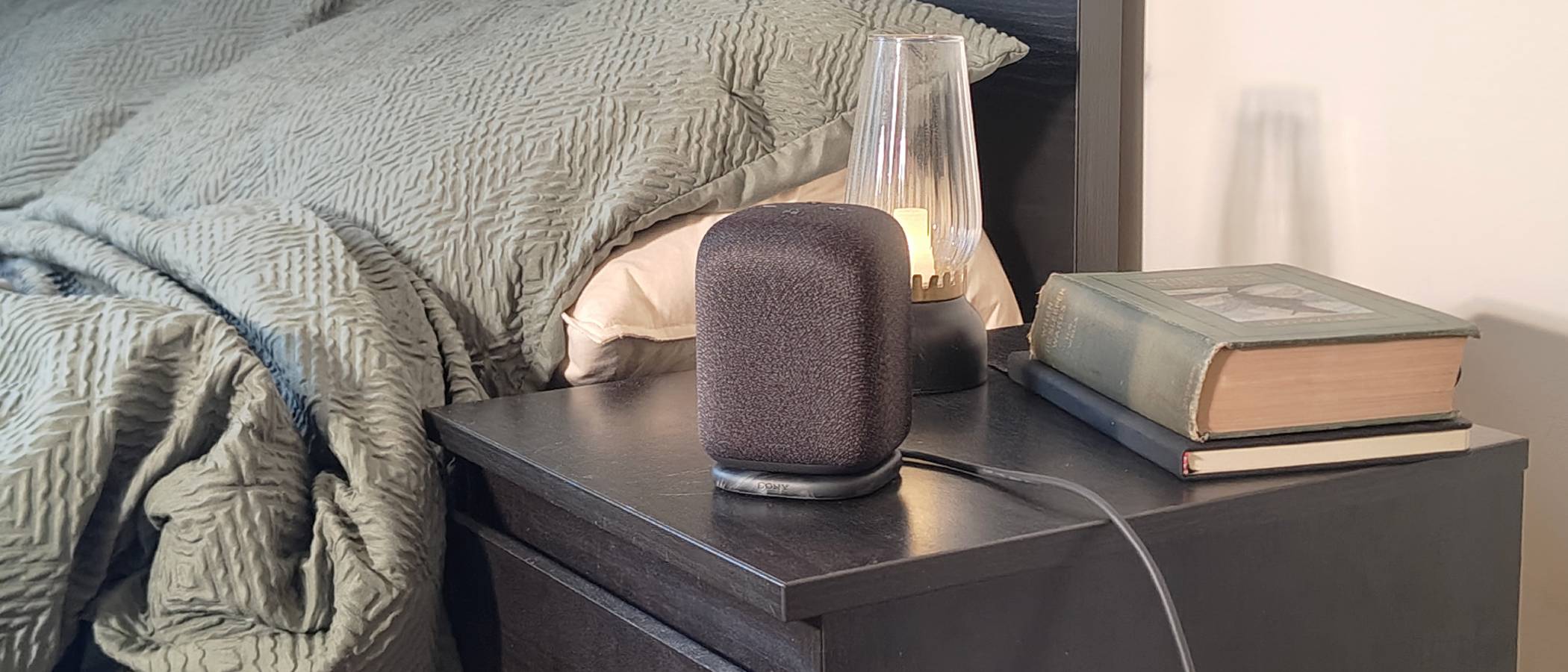TechRadar Verdict
While it's not the best-sounding speaker on the market, the Sony LinkBuds Speaker overcompensates with a range of useful features, a stellar battery life and a really useful charging plate included in the box. It's a speaker that wants to fit into your home life, not into your party, and it works great.
Pros
- +
Long-lasting battery
- +
Handy charging plate
- +
Nice and small
Cons
- -
Audio can be beaten
- -
Some features hidden or locked down
- -
Listening angle severely affects sonic experience
Why you can trust TechRadar
Sony LinkBuds Speaker: Two-minute review
Sony has released a fair few speakers in its day but the new LinkBuds Speaker is the first to be released under its LinkBuds branding; the original Sony LinkBuds were novel for having open-ring designs so you could hear your surroundings while also streaming music, but the name now just seems to be used for a range of lifestyle audio options instead of applying to that particular open design, so here we are.
I often having to get name whingeing out of the way early when I review products like the Sony LinkBuds Speaker, because I want to save the rest of the review to focus on compliments on the device (and because I love a good name-whinge).
Don’t make the mistake I did when I first started using the speaker – unlike many other entries into our annals of the best Bluetooth speakers, this creation isn’t designed for house parties or loud gatherings. Instead, it’s a svelte house-trained pet that does its best work when you keep it domestic.
That’s most evident from the charging cradle, which was my favorite aspect of the entire speaker. It charges the speaker when you’re not using it (or when you are), acting as a hub that you can easily whisk the speaker away from when you’re marching into another room.
But there’s more evidence as to the LinkBuds Speaker’s introverted state. Its understated design means it fits snugly into your home decor, but it's not as rugged as the best waterproof speakers. Its microphone means you can use it as an ersatz home assistant (via your phone, at least) and a range of other features such as a programmable musical alarm clock and hourly time alerts all indicate that this is a housebound gadget.
That doesn’t mean you’ll be left in the lurch if you take it outside, especially with a surprisingly big 25-hour battery, but you might not find the audio fits parties or summer cookouts. That’s doubly the case with audio which proves quite directional, and doesn’t quite equal some rivals on the market in terms of energy and vibrancy – if you’re looking for a party speaker, the Sony will disappoint.
I was pleasantly surprised with the feature set offered by Sony, with its Sound Connect app boasting quite a few handy features – some are ones I haven’t seen on rival devices, which is a neat touch. Admittedly some of these features are hidden deep in the app – I still have no idea how I enabled the aforementioned hourly notification – and not all of them work wonders.
But it’s another illustration of how the Sony offers brains over the raw brawn of some of its rivals. It’s no slouch in the audio department, but it’s found a different way to best the likes of the JBL Flip 6: the features.
I should cap this intro by saying one more thing if you like the ideas of these extra features: only buy this if you use Spotify, Amazon Music or Endel. Loads of the extra features require a subscription to one of these three streaming services so you're not going to be able to use all the features if you use Tidal, Apple Music or YouTube Music.
Sony LinkBuds Speaker review: Price and release date
- Released in October 2024
- Officially priced at $179.99 / £139 / AU$249
The Sony LinkBuds Speaker was announced in October 2024, alongside two new earbud additions to the brand: the LinkBuds Fit and LinkBuds Open.
You can buy the speaker for $179.99 / £139 / AU$249 so it costs a little more than rivals in the area such as the JBL Flip 6, Ultimate Ears Boom 4 or Bose SoundLink Flex, but it roughly matches the Sonos Roam 2 which we rate as the best Bluetooth speaker.
I should point out that at the time of testing, three months after the LinkBuds Speaker’s release, it’s already on offer from some retailers, so it’s worth hunting around to find a discount as they're easy to find.
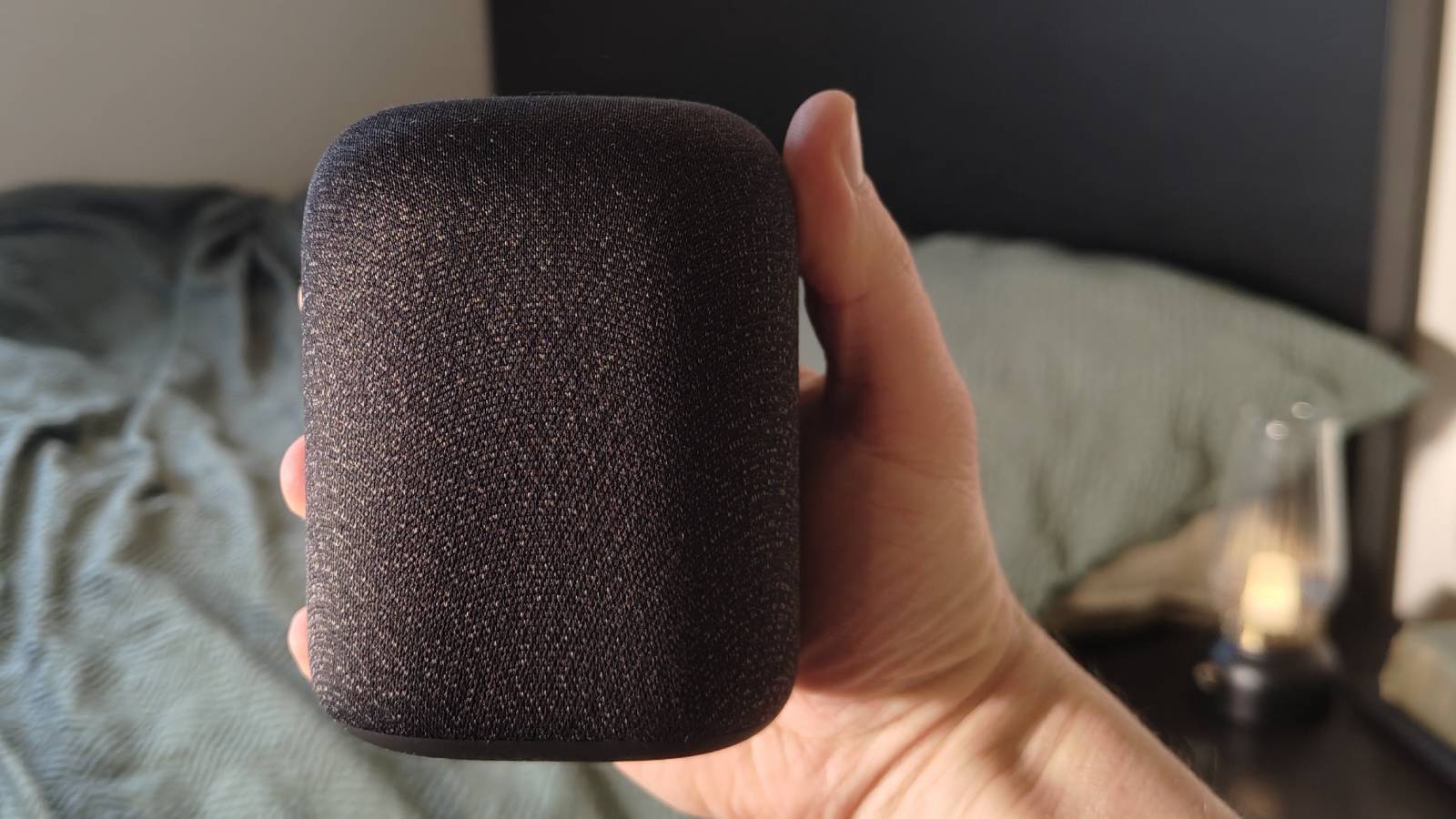
Sony LinkBuds Speaker review: Specs
Weight: | 520g |
Dimensions: | 8.4 x 11 x 9 cm |
Battery life (quoted): | 25 hours |
Connectivity: | Bluetooth 5.2 |
Drivers: | 1x tweeter, 1x woofer |
Aux in: | No |
Charger port: | USB-C |
Microphone: | Yes |
Waterproof rating: | IPX4 |
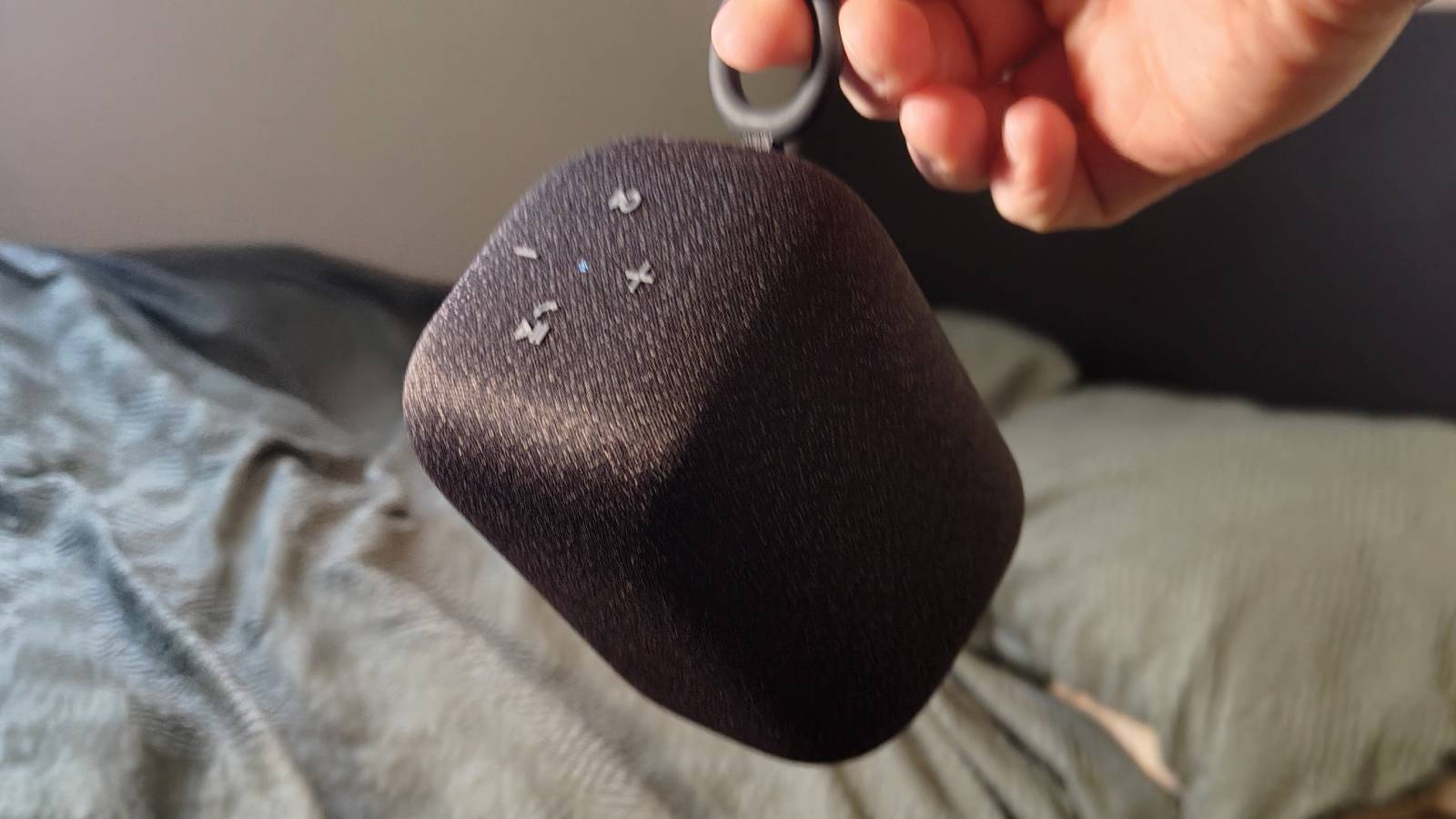
Sony LinkBuds Speaker: Features
- A 25-hour battery life
- Lots of features thanks to Sound Connect app
- Many tools require Spotify, Amazon Music or Endel
The Sony LinkBuds Speaker offers a surprisingly admirable 25 hours of battery life, which laps most of its close rivals – you can expect between 10 and 15 hours of listening time on its competitors.
Thanks to how the aforementioned charging cradle fits into my real-world experience, I never actually had to test this figure the hard way, but that’s not the end of the world – it just goes to prove that you’ll never have battery anxiety with the LinkBuds Speaker.
You can get many more features from the LinkBuds Speaker by using Sony’s Sound Connect app – until recently called Headphones Connect.
One useful feature is auto-play, so you can set your speaker to start auto-playing from Spotify, Amazon Music or Endel at certain times on certain days, basically like an alarm clock. In my testing, I was unable to choose which playlist Spotify auto-played from, and it default to carrying on whatever I last listened to, but the writing in the app suggests that I should be able to pick them. Hopefully a software update will change this.
As I'll discuss in the Design section of this review, the speaker has a quick access button. Using the app, you can map this to use two of: Spotify Tap, Amazon Music Play Now or Endel Quick Access (all three bring up a curated playlist from the app of choice). As you can tell, these are the only three apps supported by Sony’s app – sorry, Tidal fans – but you can use other streaming platforms for standard speaker playback. You just can’t use the extra features.
Audiophiles will also be pleased to hear that there’s an in-app equalizer. It’s a five-band one with an extra Clear Bass dial to increase or decrease bass prominence between -10 and 10. You can save two different custom EQs, and there are no presets. In my experience I didn’t find that the equalizer made much of a difference on the sound quality.
Sony’s auto-EQ mode is back, but I’ve not previously been impressed by this, and the LinkBuds Speaker didn’t change that. The way it works is that the app presents you with five different EQ mixes and you have to choose your favorite; you do this twice and the app creates a custom mix for you. The problem is that the mixes it suggests to you are often so indistinct that I can never tell the difference between them, so it’s not a good way of gauging my actual tastes.
I was impressed by a few of the quality-of-life features Sound Connect offers. You can choose the auto-power-off length, toggle on a battery-saving mode that stops you overcharging the speaker, connect two multiple devices (including LinkBuds earbuds, which can automatically switch your music from the buds to the speaker when you get near) and can enable a Sony-made audio decompression feature to improve the sound of music on lossy streaming services. They all just improve the way you use the speaker in small but meaningful ways.
A feature I got really close to liking is the ability to set hourly reminders. This was surprisingly convenient to help mark the passage of time through the day, reminding me that it was lunchtime or that my working hours were finished… except there's no way in the app to silence it for certain hours. I was woken several times by the speaker announcing that it was 2am or 3am and so turned this otherwise-handy feature off.
I’ll briefly touch on pairing: when I first started using the LinkBuds Speaker, I simply couldn’t connect to it via Bluetooth pairing. However as soon as I opened the Sound Connect app, it immediately recognized and paired. So if you’ve just bought this gadget and can’t get it to connect, download the app now!
- Features score: 4/5
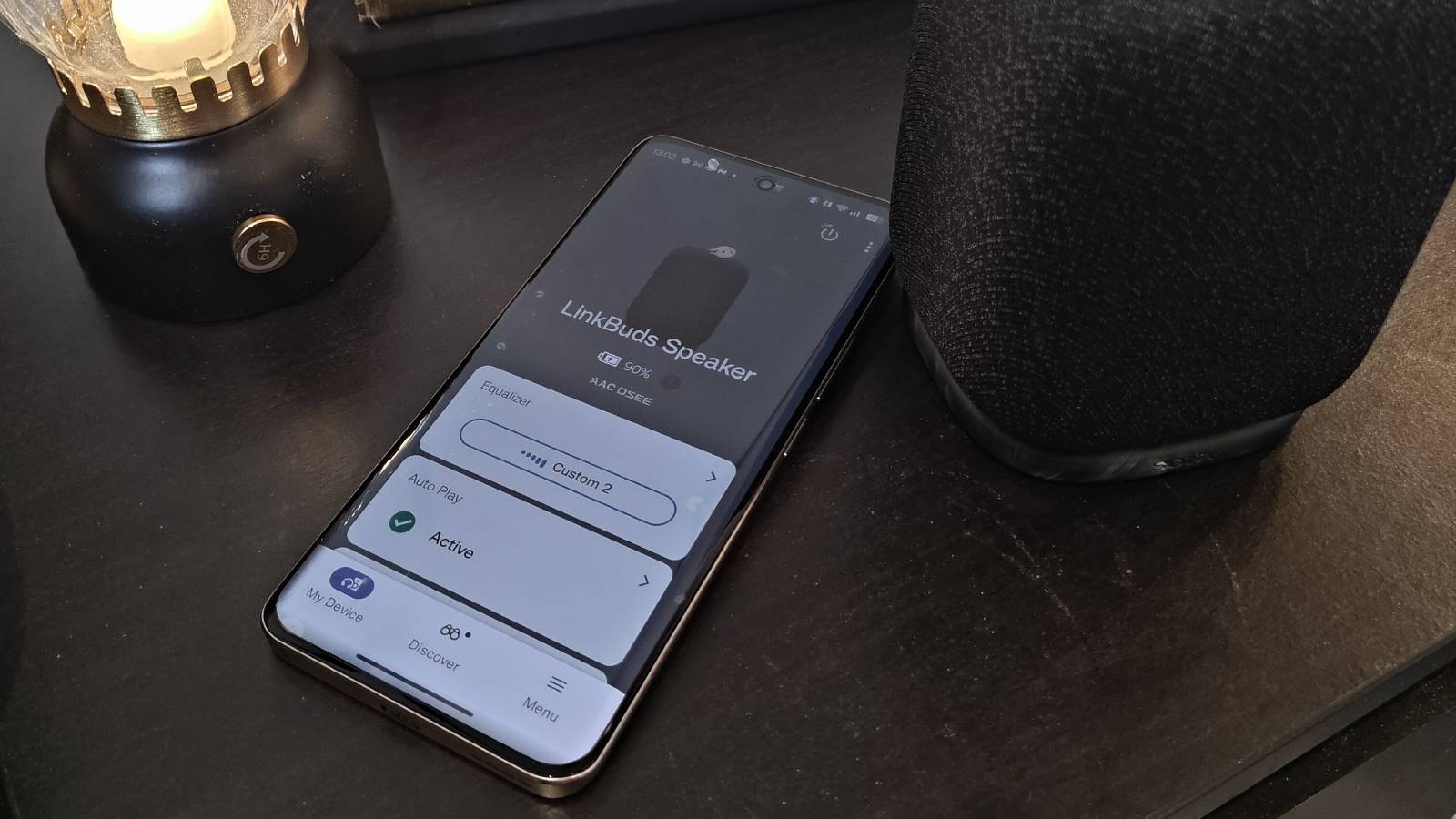
Sony LinkBuds Speaker review: Design
- Black or gray squoval
- Has a hook for hanging; charging pad in box
- A fair range of buttons
The Sony LinkBuds Speaker basically looks like a small furry squoval. (It's a real word! A portmanteau of square and oval!) Compared to lots of other portable speakers it’s a little plain looking, but I liked how it blended into the background of my home more than other speakers I test. Sometimes nondescript is good. The fabric cover also gives it a premium look that many other rivals lack.
It’s not a huge speaker, measuring 11cm tall and with body dimensions of 8.4 x 9cm, but it’s a little heavier than you’d think at first glance at 520g.
The ‘back’ of the speaker – a word I use because the sound is pretty directional, as I’ll get into in the sound quality section – has its power button as well as the USB-C charging port (which you can use instead of the included base plate, another feature I’ll explain later on). It also has a hook that you can use to hang the speaker on a hook in the bathroom, on the back of a chair or wherever works – but it’s not that big so it was hard to clip onto certain objects, plus the way the speaker hangs has problems with the directional sound (yet another tease about a future point to discuss).
On top of the speaker are buttons: volume up, volume down, play/pause/accept phone call, and the quick access button. There’s also a small light: white when the speaker is on and red when it’s off, and purple sometimes… for some reason? If there’s a way of turning the LED off, I couldn’t find it, which was a little annoying at night.
I’d be remiss not to include mention of the LinkBuds Speaker’s base plate, because it became an integral part of the experience during my testing. Included in the box is a charging cradle, which you plug into a USB-C charger, and it holds the speaker firm and slowly charges it up. Once I set this up in my office, it became a ‘home’ of sorts for the speaker – when I was listening during work, it would power up so that there was charge for when I was taking it out and about. Super convenient, two thumbs up from me.
You can buy the speaker in black or light gray, and your choice will affect the base plate as well as the speaker itself. It has an IPX4 rating so it’s protected against splashes of water but not solid jets or submersion, so it may not be at home at a pool party.
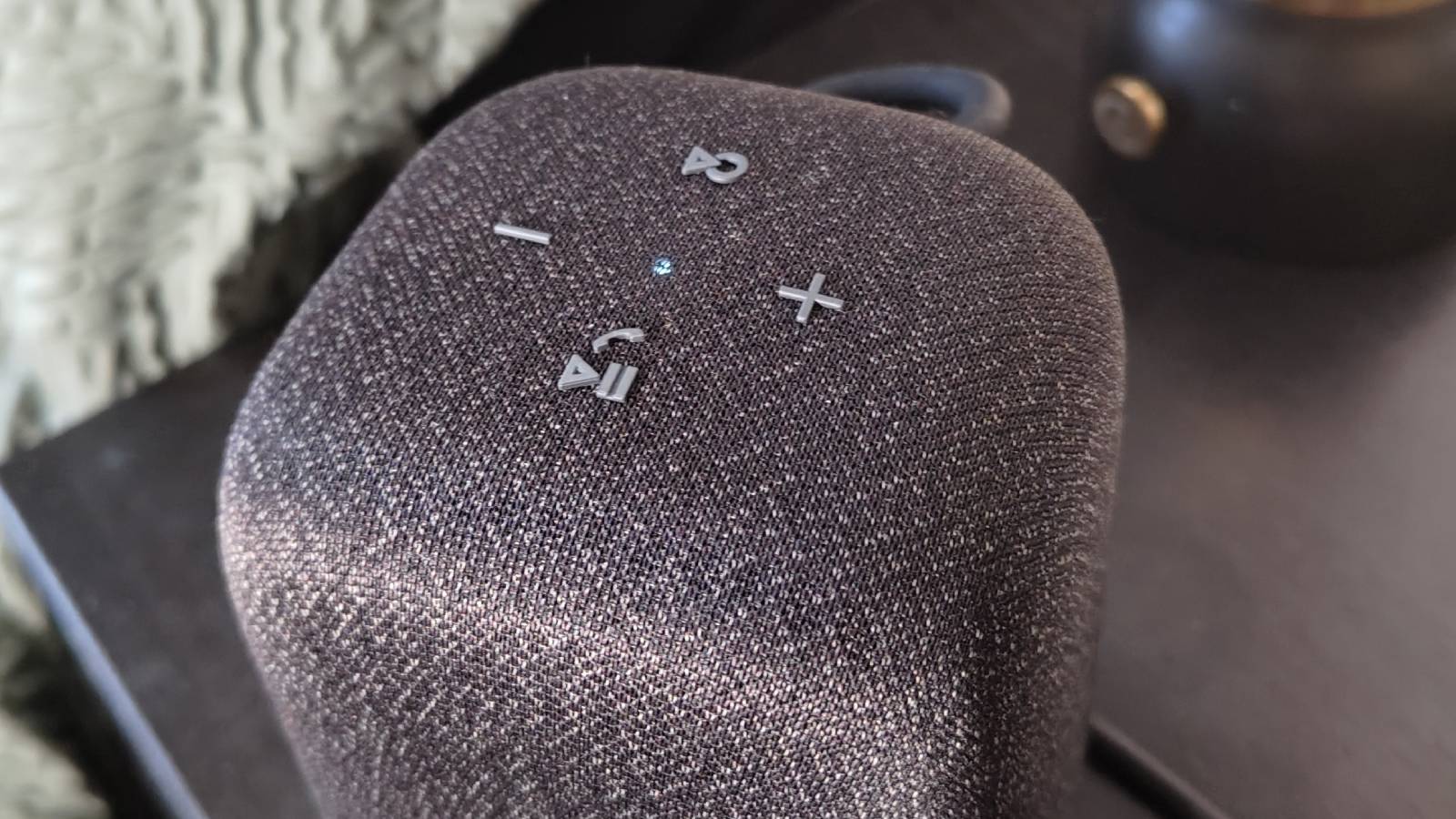
- Design score: 4/5
Sony LinkBuds Speaker review: Sound quality
- Good, not great audio quality
- Volume fine indoors but not loud enough for outdoors
- Directional audio poses a problem
The Sony LinkBuds Speaker combines a tweeter and woofer in a classic two-way system; I couldn’t find much information on either component from Sony's materials.
There’s no use beating about the bush; the LinkBuds Speaker doesn’t quite sound as great as rivals I’ve tested at this price point from Ultimate Ears and JBL. It offers a balanced audio mix, but lacks the 'oomph' that portable Bluetooth speakers generally need.
For example: there’s ample bass, but not as much as you’d get on an outdoor speaker; clear treble, but a distinct lack of shine to some instruments; the same lack of soundstage that you get on smaller speakers like this thanks to mono audio. The maximum volume is sufficient if you plan to use the speaker exclusively at home or in your garden, but in wider open spaces, it might prove hard to hear. Unlike its rivals, Sony hasn't turned any one element up to 11.
The mono audio problem can be fixed, according to the Sony website, by simply buying a second speaker and pairing them together to get stereo sound. That will, of course, double the amount you’re paying to listen.
My main concern when I started listening to the LinkBuds Speaker was simply that audio didn’t sound as energetic or exciting as on many other portable speakers I’ve tested; lots of rivals are designed as party devices and going in with the same expectations here will leave you disappointed.
This was underlined when I used the LinkBuds Speaker to play music at a gathering; after a few drinks, balanced audio isn't as important as vibrant bass. However once I figured out that the Sony is designed for a different use case – namely home listening – I could appreciate it a little more.
The LinkBuds Speaker’s sound depends a lot on the direction you are to it – that’s not uncommon in speakers, as 360-degree audio is a rare treat. But it makes a marked difference in the LinkBuds Speaker, and it’s doubly annoying for two reasons.
Firstly, due to its design, it’s pretty hard to glean which way the front is from a glance – close up, you can see the way the buttons are facing and where the hook is. If the speaker is in the corner of a room, you’ll have to guess if you’re getting the full experience. Secondly, when you use the hook to hang the speaker up, its positioning means that the tweeter and woofer point downwards – the only person getting optimal audio is the downstairs neighbor.
Sony boasts about its Sound Diffusion Processor in the LinkBuds’ web post, which is supposed to spread sound from the speaker out into a wide area, but I can only assume this listing was written on opposite day because my experience was that music sounded so much better when the speaker was facing you.
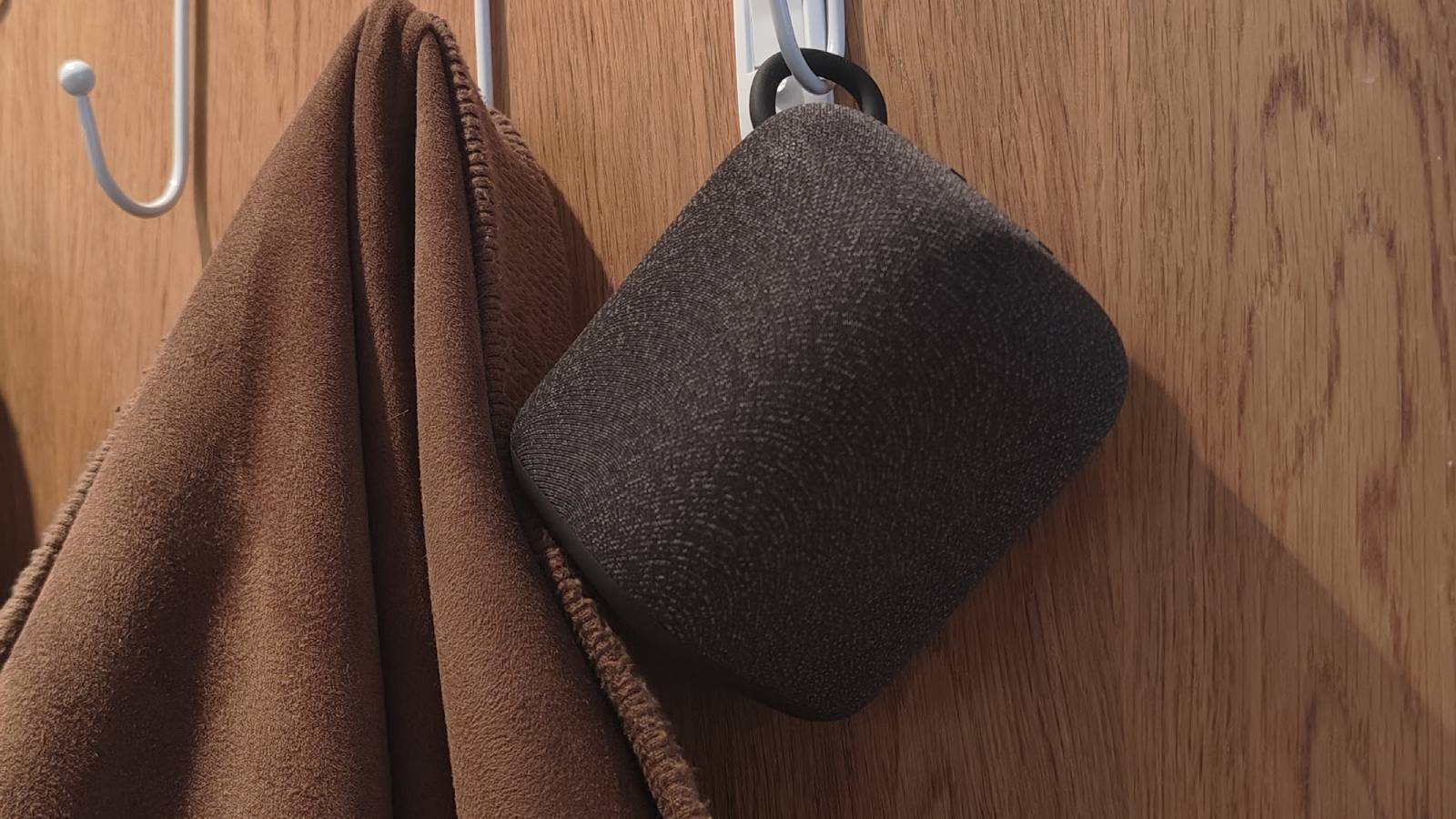
- Sound quality: 3.5/5
Sony LinkBuds Speaker review: Value
I can't go so far as to say that the Sony LinkBuds Speaker is outstanding value for money, but it ticks all the boxes that you want when you're paying this much.
The range of features, the audio quality, the design; I'm pretty sure I'd be able to accurately predict the LinkBuds' price because it's in line with expectations.
That changes a little if you can find the speaker discounted, though, and if you find it nearing the $100 / £100 / AU$180 mark, it may tip more into 'must-buy' territory.
- Value score: 3.5/5
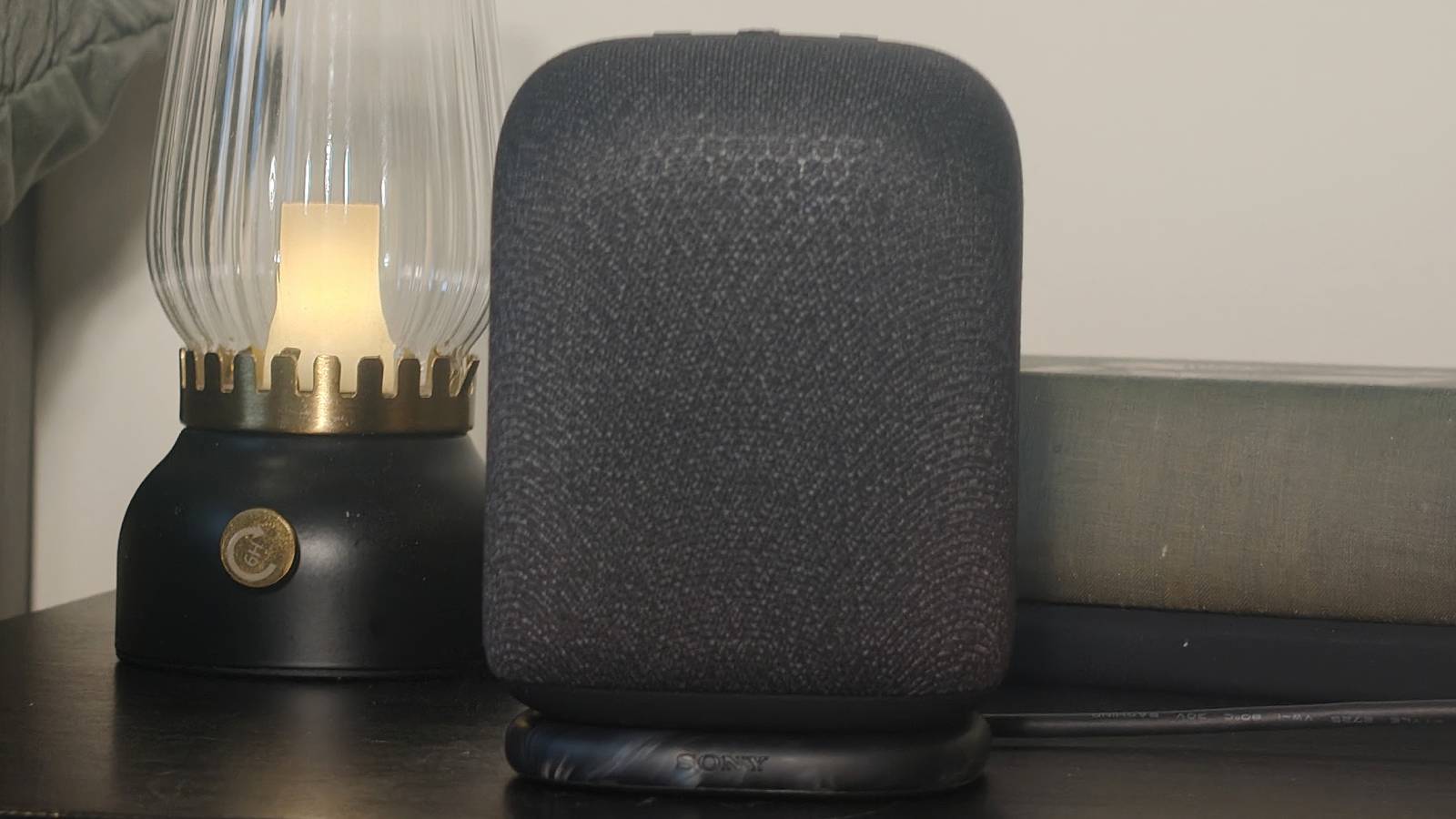
Should I buy the Sony LinkBuds Speaker?
Attributes | Notes | Rating |
|---|---|---|
Features | A range of useful features sets the LinkBuds apart from rivals. | 4/5 |
Design | It has an understated design with a few neat flourishes and touches. | 4/5 |
Sound quality | While it doesn't quite match competitors, the Sony still provides solid audio. | 3.5/5 |
Value | It's priced reasonably, if not quite competitively. | 3.5/5 |
Buy it if…
You're a homebody
Looking for a Bluetooth speaker that you plan to use at home, rather than in outdoor events? Look no further.
Battery life is important
No-one likes that most gadgets take constant charging. You can put it off for 25 hours at a time with the LinkBuds Speaker, and top it up super-easily.
You want to be woken up by music
The LinkBuds Speaker's musical alarm clock feature has woken me up for the last week, and I'm all for it.
Don’t buy it if…
You're a party planner
The LinkBuds Speaker lacks the max volume, overwhelming bass or rugged design needed to make it a real party speaker.
You're not an app fan
Some people don't like having to use an app to control their speaker or headphones, and that's a fair stance, but you won't like the LinkBuds Speaker in that case.
Sony LinkBuds Speaker review: Also consider
| Header Cell - Column 0 | Sony LinkBuds Speaker | JBL Flip 6 | Bose SoundLink Flex (Gen 2) |
|---|---|---|---|
Weight: | 520g | 550g | 590g |
Dimensions: | 8.4 x 11 x 9 cm | 17.8 x 6.8 x 7.2 cm | 9 x 20 x 5.2 cm |
Battery life (quoted): | 25 hours | 12 hours | 12 hours |
Connectivity: | Bluetooth 5.2 | Bluetooth 5.1 | Bluetooth 5.3 |
Drivers: | 1x tweeter, 1x woofer | 1x tweeter, 1x woofer | Not specified |
Aux-in: | No | No | No |
Charger port: | USB-C | USB-C | USB-C |
Microphone: | Yes | No | Yes |
Waterproof rating: | IPX4 | IP67 | IP67 |
JBL Flip 6
It's been around for years, but it remains a stalwart rival in the Bluetooth speaker space. It has a balanced sound and a hardy design, though it lacks some features (and the long battery life) that the Sony has – you can dig into it in our full JBL Flip 6 review.
Bose Soundlink Flex Gen 2
Another well-received rival from Bose, this gadget takes some party speaker DNA but not as much as some other rivals. It provide balanced audio, but perhaps doesn't quite have the charm of the Sony, but you can read more in our full Bose SoundLink Flex Gen 2 review.

Tom Bedford joined TechRadar in early 2019 as a staff writer, and left the team as deputy phones editor in late 2022 to work for entertainment site (and TR sister-site) What To Watch. He continues to contribute on a freelance basis for several sections including phones, audio and fitness.
You must confirm your public display name before commenting
Please logout and then login again, you will then be prompted to enter your display name.
